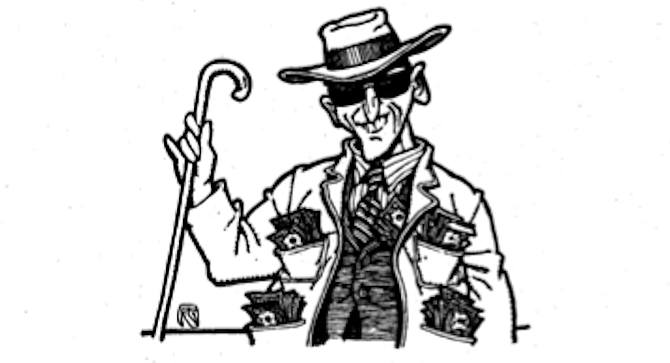 Facebook
Facebook
 X
X
 Instagram
Instagram
 TikTok
TikTok
 Youtube
Youtube

Matt: You know how ATM machines are... every bank is different. Some have buttons next to the screen, some have buttons on the counter below the screens. Some ask you if you want $20, $40, $100, and some ask you to enter the amount you want. Some will ask if you want Spanish or English. Others ask if they can charge a fee. I understand the Braille embossed on the buttons helps the visually impaired to function. What I want to know, yes, need to know. Matt, is how the visually impaired using an ATM know the prompts that are actually on the screen? — Ttashe, the Net
Matthew: Okay, once and for all, please answer the ultimate senseless question. Why the hell would a bank put Braille instructions on the drive-up ATM? — 20/20, San Diego
ATM machines are adapted to the blind in varying degrees of helpfulness, but the ones found outside banks are usually the most detailed. Ever notice the large blocks of Braille text? Ever notice the beep tones? The text tells you what to do at each step of the operation, the beeps help you keep track of where you are.
Banks that have Braille drive-up ATMs, according to one local institution, have chosen to install only one type of keypad for all their machines, walk-up or drive-up types. And despite our suspicions, banks are not unaware of the irony.
Now, ignore the preceding. A survey conducted with the help of the Service Center for the Blind in San Diego reveals that the blind are smart enough not to use ATMs. If people with perfectly good vision can be robbed there, they reason, what chance does a blind person have? (Think about it. When was the last time you saw a guide dog trying to stick a cash card in that little slot?) The vision-impaired generally cash checks in banks or the local supermarket — someplace they’re familiar with and where they feel safe. The rest of us are the ones who wheel around town flinging cash at various retailers, suddenly run out of green, and have to stop off at a 7-Eleven to refill our wallets. They’re a spending incentive for some, but not all.


Matt: You know how ATM machines are... every bank is different. Some have buttons next to the screen, some have buttons on the counter below the screens. Some ask you if you want $20, $40, $100, and some ask you to enter the amount you want. Some will ask if you want Spanish or English. Others ask if they can charge a fee. I understand the Braille embossed on the buttons helps the visually impaired to function. What I want to know, yes, need to know. Matt, is how the visually impaired using an ATM know the prompts that are actually on the screen? — Ttashe, the Net
Matthew: Okay, once and for all, please answer the ultimate senseless question. Why the hell would a bank put Braille instructions on the drive-up ATM? — 20/20, San Diego
ATM machines are adapted to the blind in varying degrees of helpfulness, but the ones found outside banks are usually the most detailed. Ever notice the large blocks of Braille text? Ever notice the beep tones? The text tells you what to do at each step of the operation, the beeps help you keep track of where you are.
Banks that have Braille drive-up ATMs, according to one local institution, have chosen to install only one type of keypad for all their machines, walk-up or drive-up types. And despite our suspicions, banks are not unaware of the irony.
Now, ignore the preceding. A survey conducted with the help of the Service Center for the Blind in San Diego reveals that the blind are smart enough not to use ATMs. If people with perfectly good vision can be robbed there, they reason, what chance does a blind person have? (Think about it. When was the last time you saw a guide dog trying to stick a cash card in that little slot?) The vision-impaired generally cash checks in banks or the local supermarket — someplace they’re familiar with and where they feel safe. The rest of us are the ones who wheel around town flinging cash at various retailers, suddenly run out of green, and have to stop off at a 7-Eleven to refill our wallets. They’re a spending incentive for some, but not all.
Comments